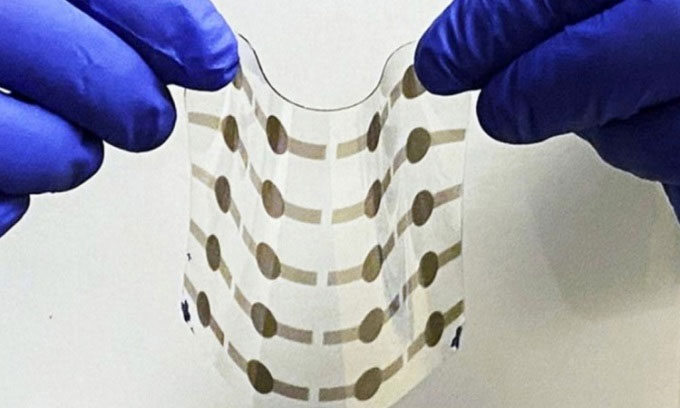Scientists develop artificial muscles that are 10 times stronger than real muscles
Researchers at the University of California, Los Angeles (UCLA) have developed a new material to produce artificial muscles that are stronger and more flexible than many natural muscles.

Membrane made of 10 layers of PHDE. (Photo: UCLA)
In collaboration with the non-profit organization SRI International, the UCLA team used readily available chemicals and ultraviolet (UV)-based treatments to improve the layer of dielectric elastomer (DE). This type of material is not only malleable and strong, but also lightweight and has a high energy density. DEs are polymers that can change size or shape when an electric field is applied, making them ideal for making actuators. DE produced from acrylic can withstand high pressure but needs pre-stretching and is difficult to bend. In contrast, DE made from silicon is easy to fabricate but cannot withstand high pressure.
The team was able to modify the cross-linking in the polymer's chain of the material to make DE that is softer, easier to drink and increases in size in a simpler way without losing strength or toughness. Changes in the manufacturing process allowed them to produce thin DE films called easy-to-process high-performance dielectric elastomers (PHDEs). The PHDE film is as thin and light as a human hair. Stacking multiple layers of PHDE membranes could help researchers create tiny actuators that behave like muscle tissue and produce enough muscle to operate a small robot.
The team also applied a simplified process that aligns the PHDE film with a blade, followed by a UV lamp treatment. As a result, they were able to produce actuators similar to spider legs with the ability to bend and jump, or turn and spin.
The actuators from PHDE can produce more force and are 3-10 times more flexible than natural muscles. For example, the new actuator can throw a ball 20 times heavier. According to Qibing Pei, a professor of materials science and engineering at UCLA, this actuator could pave the way for artificial muscles on robots or sensors and technology to accurately simulate and even improve human-like movements. People.
- Synthetic muscles help AI strong and skillful like in fantasy movies
- Successfully developing artificial muscles like real ones, being able to reproduce themselves
- Artificial leather bulletproof
- The artificial mechanics lift 1,000 times heavier objects, opening the future for robots that are just like humans
- Scientists have developed artificial skin that feels like real leather
- The muscle is 200 times stronger
- Artificial blood can save patients' lives like real blood
- Artificial muscles from synthetic fibers
- Will artificial muscles be used to test drugs?
- Counterfeit works like a real thing
- Development of artificial skin from mushrooms that looks like real leather
- The discovery of 'muscle disappearing' in humans more than 250 million years ago
 The US company is about to build a supersonic passenger plane of 6,000km / h
The US company is about to build a supersonic passenger plane of 6,000km / h Japan develops avatar robot as in fiction film
Japan develops avatar robot as in fiction film Australia tested the world's first mango picking robot
Australia tested the world's first mango picking robot America develops technology to separate water from animal waste
America develops technology to separate water from animal waste Mold may be 'pharmaceutical factory'
Mold may be 'pharmaceutical factory'  Why does Wallaby not emit Methane?
Why does Wallaby not emit Methane?  Mexico studies the use of tilapia skin for high-end shoe production
Mexico studies the use of tilapia skin for high-end shoe production  Unexpected energy sources for the future
Unexpected energy sources for the future  Producing hydrogen from water and sunlight
Producing hydrogen from water and sunlight  Reduce thirst for electricity with coconut
Reduce thirst for electricity with coconut 